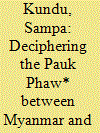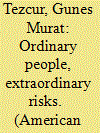| Srl | Item |
| 1 |
ID:
160499


|
|
|
|
|
| Summary/Abstract |
Myanmar’s relations with China experienced a few hiccups during former President Thein Sein’s regime. However, contrary to expectations, the current government led by Aung San Suu Kyi appears to have reversed this trend. This article argues that Aung San Suu Kyi, after coming to power in March 2016, adopted a foreign policy approach, which is proving to be somewhat similar to that of the military junta under which China became Myanmar’s most trusted friend in the region. It attempts to unfold various factors that have been shaping Myanmar’s approach towards China in recent years.
|
|
|
|
|
|
|
|
|
|
|
|
|
|
|
|
| 2 |
ID:
083667


|
|
|
|
|
| Publication |
2008.
|
| Summary/Abstract |
Ethnic insurgencies have received less scholarly attention than colonial or ideological insurgencies-even as they have become the predominant form of insurgency following the decolonization process and then the end of the Cold War. In the face of ethnic insurgencies, what determines the effectiveness of the various counterinsurgency strategies adopted by host states? Are democracies more likely to succeed by pursuing some kinds of counterinsurgency strategies rather than others? Theory indicates that multiple counterinsurgency strategies, if thoroughly implemented, can defeat ethnic insurgencies. Host state regime type-particularly democracy-is important as a constraint on the will to employ and thoroughly implement some counterinsurgency methods. Democracies are most likely to defeat ethnic insurgencies by employing more cooperative or "balanced" strategies. Although such strategies employ economic and political inducements and rely on local ethnic elements to help fight the insurgents, they also depend on a credible host state commitment to sustain the counterinsurgency for as long as it takes to win. Case studies of India's multiphased counterinsurgency efforts in Punjab and Kashmir offer some preliminary evidence in support of this theory. In both Punjab and Kashmir, early counterinsurgency efforts relied on less discriminate campaigns conducted by central armed forces or by illegitimate local proxies. The outcomes were strengthened insurgencies. In both cases, the Indian state adapted by seeking the cooperation of legitimate local moderates in more discriminate counterinsurgency efforts. These later, "balanced" strategies were more effective. This was particularly true in Punjab, where conditions for local cooperation were more favorable.
|
|
|
|
|
|
|
|
|
|
|
|
|
|
|
|
| 3 |
ID:
105520


|
|
|
| 4 |
ID:
147238


|
|
|
|
|
| Summary/Abstract |
Why do ordinary people take extraordinary risks and join an ethnic armed rebellion? This article tests a series of well-established hypotheses about selfish and identity based motivations and a new hypothesis based on prospect theory. It then employs a unique multimethod research strategy combining one of the most comprehensive datasets on insurgent recruitment that contains biographical information about 8,266 Kurdish militants with extensive fieldwork involving in-depth interviews with relatives of the militants to test these hypotheses. The findings show the decision to rebel is as much political as economic and social. While security concerns and expectations of benefits affect the decision to rebel, social commitments, identities radicalized by state repression, and collective threat perceptions among efficacious individuals generated by political mobilization, rather than preexisting ethnic cleavages, also lead to participation in an ethnic insurgency. The latter findings explain the durability of insurgencies with limited economic resources and their ability to attract educated fighters.
|
|
|
|
|
|
|
|
|
|
|
|
|
|
|
|
| 5 |
ID:
101918


|
|
|
|
|
| Publication |
2011.
|
| Summary/Abstract |
The Shan State Army-South (SSA-S) is today one of Burma's largest remaining ethnic opposition armies. This paper investigates ethnic politics of the SSA-S and their strategic use of media. It argues that Shan insurgency today has moved into a new phase characterised by its intense involvement with mass media. The paper examines, on the production side, the Shan insurgency's media products and its networking with the Thai press. On the reception side, it explores how the images of ethnic insurgency are consumed by Shan audiences living in exile, analysing how long-distance Shan nationalism is generated through the spectatorship of these 'militarised' images.
|
|
|
|
|
|
|
|
|
|
|
|
|
|
|
|